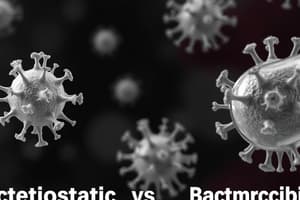Podcast
Questions and Answers
What is microbial growth defined as?
What is microbial growth defined as?
The process of an increase in the number of microorganisms through cell division or replication.
What are psychrophiles?
What are psychrophiles?
Extremophilic bacteria or archaea that grow optimally at about 15°C or lower.
Mesophiles have an optimum growth temperature of 15°C.
Mesophiles have an optimum growth temperature of 15°C.
False (B)
What pH range do most bacteria grow best in?
What pH range do most bacteria grow best in?
What is nitrogen fixation?
What is nitrogen fixation?
What is a culture medium?
What is a culture medium?
What is the role of agar in culture media?
What is the role of agar in culture media?
Complex media have a fixed chemical composition.
Complex media have a fixed chemical composition.
Match the following types of bacteria with their characteristics:
Match the following types of bacteria with their characteristics:
Flashcards are hidden until you start studying
Study Notes
Microbial Growth
- Microbial growth involves an increase in the number of microorganisms through cell division, not an increase in cell size.
- Growth is exponential under favorable conditions.
Requirements for Growth: Physical Conditions
-
Temperature:
- Most microorganisms thrive at temperatures preferred by humans.
- Psychrophiles: Optimal growth at 15°C, maximal at 20°C, and minimal at 0°C.
- Mesophiles: Optimal growth between 30-40°C.
- Thermophiles: Optimal growth between 50-60°C.
-
Psychrophiles vs. Psychrotrophs:
- Psychrophiles are cold-loving and require temperatures typically at or below 15°C.
- Psychrotrophs can grow at lower temperatures but prefer warmer conditions.
-
pH Levels:
- Most bacteria flourish in the pH range of 6.5 to 7.5.
- Acidophiles tolerate acidic conditions.
- Alkaliphiles thrive in alkaline environments.
-
Osmotic Pressure:
- Hypertonic environments can lead to plasmolysis.
- Extreme halophiles require high osmotic pressure.
- Facultative halophiles can tolerate high osmotic pressure, while most microorganisms need nearly isotonic conditions.
Requirements for Growth: Chemical Conditions
-
Carbon:
- Essential for structural organic molecules; constitutes about half of a bacterial cell's dry weight.
- Chemoheterotrophs utilize organic carbon sources, while autotrophs use CO2.
-
Nitrogen:
- Comprises approximately 14% of a bacterial cell's dry weight; vital for nucleic acids and proteins.
- Bacteria often derive nitrogen from decomposing proteins or utilize NH4+ and NO3-.
- Nitrogen fixation converts atmospheric N2 into usable forms like nitrates and ammonium.
-
Sulfur:
- Important in amino acids, vitamins (e.g., thiamine, biotin).
- Obtained from decomposing sulfur-containing amino acids or using SO42- and H2S.
-
Phosphorus:
- Found in DNA, RNA, ATP, and cellular membranes; sourced from PO43-.
-
Trace Elements:
- Includes iron, copper, molybdenum, and zinc, required in small amounts as enzyme cofactors.
-
Organic Growth Factors:
- Organic compounds, including vitamins and amino acids, obtained from the environment.
Culture Media
-
Culture Medium:
- Nutrient-rich preparation designed to support microbial growth.
-
Inoculum:
- The introduction of microbes into the culture medium.
-
Culture:
- The result of microbial growth in or on the culture medium.
-
Criteria for Effective Culture Medium:
- Must contain appropriate nutrients, moisture, proper pH, suitable oxygen levels, be sterile, and allow for proper incubation temperature.
-
Agar:
- A complex polysaccharide used as a solidifying agent in culture media.
- Liquefies at 100°C and solidifies around 40°C, typically not metabolized by microbes.
Types of Culture Media
-
Chemically Defined Media:
- Designed for autotrophic bacteria, with a known chemical composition.
-
Complex Media:
- Used for heterotrophic bacteria and fungi with variable chemical composition.
- Provided by extracts and digests of yeasts, meats, or plants, supplying the energy, carbon, nitrogen, and sulfur needs of organisms mostly through proteins.
Studying That Suits You
Use AI to generate personalized quizzes and flashcards to suit your learning preferences.




